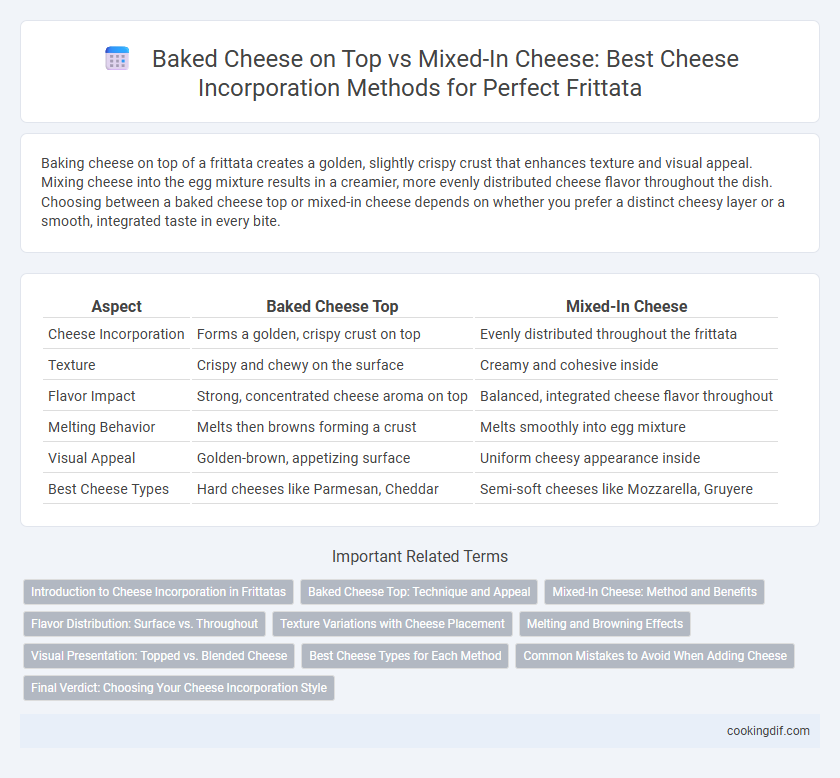Baking cheese on top of a frittata creates a golden, slightly crispy crust that enhances texture and visual appeal. Mixing cheese into the egg mixture results in a creamier, more evenly distributed cheese flavor throughout the dish. Choosing between a baked cheese top or mixed-in cheese depends on whether you prefer a distinct cheesy layer or a smooth, integrated taste in every bite.
Table of Comparison
| Aspect | Baked Cheese Top | Mixed-In Cheese |
|---|---|---|
| Cheese Incorporation | Forms a golden, crispy crust on top | Evenly distributed throughout the frittata |
| Texture | Crispy and chewy on the surface | Creamy and cohesive inside |
| Flavor Impact | Strong, concentrated cheese aroma on top | Balanced, integrated cheese flavor throughout |
| Melting Behavior | Melts then browns forming a crust | Melts smoothly into egg mixture |
| Visual Appeal | Golden-brown, appetizing surface | Uniform cheesy appearance inside |
| Best Cheese Types | Hard cheeses like Parmesan, Cheddar | Semi-soft cheeses like Mozzarella, Gruyere |
Introduction to Cheese Incorporation in Frittatas
Baked cheese topping on frittatas creates a golden, crispy crust that enhances texture and visual appeal, while mixed-in cheese integrates seamlessly, providing creamy, even flavor throughout. Types like mozzarella or cheddar melt smoothly when mixed in, ensuring a rich, cohesive bite in every forkful. Choosing between these methods depends on desired texture and presentation, as both techniques effectively incorporate cheese's savory richness.
Baked Cheese Top: Technique and Appeal
Baked cheese top in a frittata creates a golden, crispy crust that enhances both flavor and texture, offering an appealing contrast to the soft interior. This technique involves sprinkling cheese evenly over the surface before baking, allowing it to melt and brown under direct heat. The result is a visually enticing, savory layer that intensifies cheesy richness and adds a satisfying crunch.
Mixed-In Cheese: Method and Benefits
Incorporating cheese mixed into the frittata batter ensures even distribution of creamy texture and rich flavor throughout each bite, enhancing the overall mouthfeel. This method allows the cheese to melt uniformly during baking, preventing a dry or overly browned top crust common with baked cheese toppings. Mixed-in cheese helps maintain moisture and creates a harmonious balance between eggs and cheese, contributing to a tender and flavorful frittata.
Flavor Distribution: Surface vs. Throughout
Baked cheese on top of a frittata creates a rich, caramelized crust that delivers intense bursts of flavor with each bite, emphasizing surface-level taste. Mixed-in cheese blends evenly throughout the egg mixture, ensuring consistent flavor distribution and a creamy texture in every forkful. The choice between the two affects how cheese flavor is experienced, with the top layer offering concentrated richness and mixed-in cheese providing uniform savoriness.
Texture Variations with Cheese Placement
Baked cheese on top of a frittata creates a crispy, golden crust that contrasts with the soft, custardy interior, enhancing textural depth. Mixing cheese throughout the egg mixture results in a uniformly creamy texture with pockets of melted richness dispersed evenly. The placement of cheese directly influences the frittata's mouthfeel, balancing crispness and creaminess depending on whether it is baked on top or integrated into the mixture.
Melting and Browning Effects
Baked cheese on top of a frittata creates a golden, crispy crust that enhances visual appeal and provides a contrasting texture to the soft interior. Mixing cheese into the egg mixture ensures even melting throughout, resulting in a creamy, cohesive dish with pockets of gooey richness. Both methods influence the overall flavor profile and mouthfeel, with baked cheese contributing to Maillard browning and mixed-in cheese offering consistent meltiness.
Visual Presentation: Topped vs. Blended Cheese
A frittata with baked cheese on top creates a visually appealing golden crust that highlights the dish's richness and adds texture contrast. Mixed-in cheese offers a uniform, creamy consistency throughout, subtly enhancing flavor without distinct visual cues. Choosing baked cheese topping emphasizes a rustic, enticing appearance, while blended cheese favors smooth integration.
Best Cheese Types for Each Method
A baked cheese top on frittata benefits from hard cheeses like Parmesan, Gruyere, or aged Cheddar, which create a golden, crispy crust and rich umami flavor. Mixing cheese into the egg mixture suits softer, meltable cheeses such as mozzarella, feta, or goat cheese, ensuring creamy, well-distributed texture and mild tang. Selecting the right cheese type enhances the frittata's taste and texture by complementing the cooking method's characteristics.
Common Mistakes to Avoid When Adding Cheese
Common mistakes when adding cheese to a frittata include placing cheese only on top, which can cause uneven melting and a dry texture. Incorporating cheese mixed-in with eggs ensures a more uniform distribution and creamy consistency throughout. Avoid using overly moist cheeses that release water during baking, as this can lead to a soggy frittata.
Final Verdict: Choosing Your Cheese Incorporation Style
Baked cheese top on a frittata creates a golden, crispy crust that adds texture and visually appealing caramelization, while mixed-in cheese yields a creamier, uniformly cheesy interior. The choice depends on whether you prefer a distinct cheesy layer or integrated melt throughout the eggs. For a richer flavor profile and appealing presentation, the baked cheese top is ideal; for consistent cheesiness and softer texture, mixed-in cheese is optimal.
baked cheese top vs mixed-in cheese for cheese incorporation Infographic

 cookingdif.com
cookingdif.com